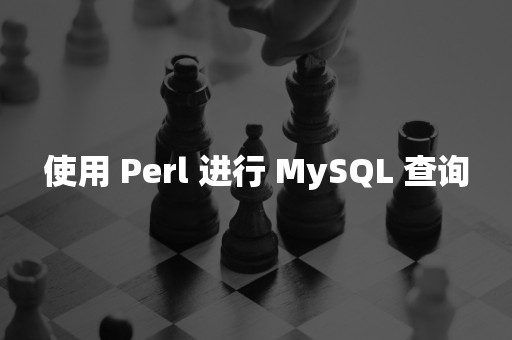麒麟v10 上部署 TiDB v5.1.2 生产环境优化实践
909
2023-04-09
使用 Perl 进行 MySQL 查询

我们已经建立了到数据库的连接,现在我们要修改并从数据库中获取数据。
使用SELECT语句从数据库中检索数据。 在 Perl DBI 中,首先我们使用prepare()方法准备 SQL 语句。 SQL 字符串被发送到数据库引擎,该引擎检查语句的有效性,语法,并在某些数据库中检查执行某些查询的用户权限。 如果一切正常,则对语句句柄的引用将返回到 Perl 脚本。 下一步是对execute()方法的调用。 该方法在数据库内执行查询。 此时,结果保留在数据库中。 Perl 脚本尚不包含数据。 对于非选择语句,execute()方法返回已知的受影响的行数。 在最后一步中,从数据库中获取数据。 数据被逐行提取并填充到 Perl 数据结构中。
Perl DBI 有几种从数据库表中获取数据的方法。
| 方法 | 描述 |
|---|---|
fetchrow_arrayref() | 获取下一行数据并返回对数组的引用。 |
fetchrow_array() | 获取下一行数据,并将其作为列表返回。 |
fetchrow_hashref() | 获取下一行数据,并将其返回为对哈希的引用。 |
fetchall_arrayref() | 提取所有数据&返回对每行有一个引用的数组的引用。 |
fetch() | 该方法是fetchrow_arrayref()的别名。 |
fetchrow() | 该方法是fetchrow_array()的别名。 |
准备并执行完 SQL 语句后,我们调用可用的访存方法之一。
| 方法 | 描述 |
|---|---|
selectrow_arrayref() | 将prepare(),execute()和fetchrow_arrayref()合并为一个呼叫。 |
selectrow_hashref() | Combines prepare(),execute()和fetchrow_hashref()进入一个通话。 |
selectrow_array() | 将prepare(),execute()和fetchrow_array()合并为一个呼叫。 |
selectall_arrayref() | 将prepare(),execute()和fetchall_arrayref()合并为一个呼叫。 |
selectall_hashref() | Combines prepare(),execute()和fetchall_hashref()进入一个通话。 |
selectcol_arrayref() | 合并prepare()和execute()并从所有行中提取一个 col 到单个调用中。 |
在第二张表中,我们列出了实用程序方法,这些方法将三个方法组合为一个调用。 它们是方便的方法。
提取方法
在第一个示例中,我们将演示fetchrow_arrayref()方法的用法。
#!/usr/bin/perluse strict;use DBI;my $dbh = DBI->connect( "dbi:mysql:dbname=mydb", "user12", "34klq*", { RaiseError => 1 }, ) or die $DBI::errstr;my $sth = $dbh->prepare("SELECT * FROM Cars LIMIT 5");$sth->execute();my $row;while ($row = $sth->fetchrow_arrayref()) { print "@$row[0] @$row[1] @$row[2]\n";}$sth->finish();$dbh->disconnect();在示例中,我们从Cars表中选择 5 行。 使用fetchrow_arrayref()方法检索数据。
my $sth = $dbh->prepare("SELECT * FROM Cars LIMIT 5");$sth->execute();这是数据检索过程的前两个阶段。 我们准备并执行SELECT语句。
my $row;while ($row = $sth->fetchrow_arrayref()) { print "@$row[0] @$row[1] @$row[2]\n";}现在,我们正在获取数据。 fetchrow_arrayref()方法获取下一行数据,并返回对包含字段值的数组的引用。 当没有更多的行了时,我们将方法放入终止的 while 循环中。
$ ./fetchrow_arrayref.pl1 Audi 526422 Mercedes 571273 Skoda 90004 Volvo 290005 Bentley 350000示例输出。
在第二个示例中,我们将使用fetchrow_array()方法。
#!/usr/bin/perluse strict;use DBI;my $dbh = DBI->connect( "dbi:mysql:dbname=mydb", "user12", "34klq*", { RaiseError => 1 }, ) or die $DBI::errstr;my $sth = $dbh->prepare( "SELECT * FROM Cars LIMIT 5" ); $sth->execute();my @row;while (@row = $sth->fetchrow_array()) { print "@row\n";}$sth->finish();$dbh->disconnect();在此脚本中,我们连接到数据库,并使用fetchrow_array()方法一张一张地获取 5 行Cars表。
my @row;while (@row = $sth->fetchrow_array()) { print "@row\n";}fetchrow_array()方法获取下一行数据,并将其作为包含字段值的列表返回。 我们使用 while 循环遍历所有 5 行。
在下一个示例中,我们将按列名称获取数据。 为此,我们将使用fetchrow_hashref()方法。
#!/usr/bin/perluse strict;use DBI;my $dbh = DBI->connect( "dbi:mysql:dbname=mydb", "user12", "34klq*", { RaiseError => 1 }, ) or die $DBI::errstr;my $sth = $dbh->prepare( "SELECT * FROM Cars LIMIT 5" ); $sth->execute();my $row;while($row = $sth->fetchrow_hashref()) { print "$row->{Id} $row->{Name} $row->{Price}\n";}$sth->finish();$dbh->disconnect();在示例中,数据以对 Perl 哈希的引用形式返回。
my $row;while($row = $sth->fetchrow_hashref()) { print "$row->{Id} $row->{Name} $row->{Price}\n";}fetchrow_hashref()方法获取下一行数据,并将其返回为对包含字段名称和字段值对的哈希的引用。 使用此方法,我们可以按列名称检索值。
在本节的最后一个示例中,我们一步一步从SELECT语句中获取所有数据。 我们使用fetchall_arrayref()方法。
#!/usr/bin/perluse strict;use DBI;my $dbh = DBI->connect( "dbi:mysql:dbname=mydb", "user12", "34klq*", { RaiseError => 1 }, ) or die $DBI::errstr;my $sth = $dbh->prepare("SELECT * FROM Cars LIMIT 5");$sth->execute();my $all = $sth->fetchall_arrayref();foreach my $row (@$all) { my ($id, $name, $price) = @$row; print "$id $name $price\n";}$sth->finish();$dbh->disconnect();该示例从Cars表中选择并打印五行。
my $all = $sth->fetchall_arrayref();我们通过一个方法调用获取所有数据。 fetchall_arrayref()方法返回对数组的引用,该数组每行包含一个引用。
foreach my $row (@$all) { my ($id, $name, $price) = @$row; print "$id $name $price\n";}我们使用 foreach 循环遍历检索到的数据。
转储数据
Perl DBI 有一个称为dump_results()的特殊方法。 此方法被设计为用于原型设计和测试查询的便捷实用程序。 它使用neat_list()方法格式化和编辑字符串以供人类阅读。 不建议将其用于数据传输应用。
#!/usr/bin/perluse strict;use DBI;my $dbh = DBI->connect( "dbi:mysql:dbname=mydb", "user12", "34klq*", { RaiseError => 1 }, ) or die $DBI::errstr;my $sth = $dbh->prepare( "SELECT * FROM Cars LIMIT 5" ); $sth->execute();$sth->dump_results(); $sth->finish();$dbh->disconnect();在示例中,我们将转储结果集中的所有数据。
my $sth = $dbh->prepare( "SELECT * FROM Cars LIMIT 5" ); $sth->execute();SQL 语句从Cars表中选择五行。 和所有三列。
$sth->dump_results(); dump_results()从语句句柄中选择所有行并进行打印。 这是用于原型制作和测试的方法。
$ ./dump.pl 1, 'Audi', 526422, 'Mercedes', 571273, 'Skoda', 90004, 'Volvo', 290005, 'Bentley', 3500005 rows这是示例的输出。
便利方法
我们将展示两个使用上述便利方法的示例。
#!/usr/bin/perluse strict;use DBI;my $dbh = DBI->connect( "dbi:mysql:dbname=mydb", "user12", "34klq*", { RaiseError => 1 }, ) or die $DBI::errstr;my $ary = $dbh->selectrow_arrayref("SELECT * FROM Cars WHERE Id = 5");print join(" ", @$ary), "\n";$dbh->disconnect();在第一个代码示例中,我们将调用selectrow_arrayref()方法。 我们从 Cars 表中选择第五行。
my $ary = $dbh->selectrow_arrayref("SELECT * FROM Cars WHERE Id = 5");selectrow_arrayref()方法将prepare(),execute()和fetchrow_arrayref()合并为一个调用。 它返回对语句第一行数据的引用。 请注意,我们不使用语句句柄。 我们使用$dbh数据库句柄对象。
print join(" ", @$ary), "\n";我们将行打印到控制台。
下面的示例显示selectall_arrayref()方法。
#!/usr/bin/perluse strict;use DBI;my $dbh = DBI->connect( "dbi:mysql:dbname=mydb", "user12", "34klq*", { RaiseError => 1 }, ) or die $DBI::errstr;my $all = $dbh->selectall_arrayref("SELECT * FROM Cars LIMIT 5");foreach my $row (@$all) { my ($id, $name, $price) = @$row; print "$id $name $price\n";}$dbh->disconnect();我们再次从Cars表中检索 5 行。
my $all = $dbh->selectall_arrayref("SELECT * FROM Cars LIMIT 5");selectall_arrayref()方法返回对数组的引用,其中包含对获取的每一行数据的数组的引用。 提供的 SQL 语句从Cars表中选择 5 行。 注意,我们既没有调用prepare()也没有调用execute()方法。 这是因为selectall_arrayref()方法将prepare(),execute()和fetchall_arrayref()组合到一个调用中。
foreach my $row (@$all) { my ($id, $name, $price) = @$row; print "$id $name $price\n";}我们遍历提取的数组数组并将数据打印到终端。
$ ./selectall_arrayref.pl1 Audi 526422 Mercedes 571273 Skoda 90004 Volvo 290005 Bentley 350000这是示例的输出。
参数化查询
现在,我们将关注参数化查询。 当使用参数化查询时,我们使用占位符,而不是直接将值写入语句。 参数化查询可提高安全性和性能。
当程序收到用户的输入时,程序员必须始终保持谨慎。 稍后,我们将值绑定到预备语句,而不是从用户输入构建字符串。
#!/usr/bin/perluse strict;use DBI;my $dbh = DBI->connect( "dbi:mysql:dbname=mydb", "user12", "34klq*", { RaiseError => 1 }, ) or die $DBI::errstr;my $id = 3;my $sth = $dbh->prepare( "SELECT * FROM Cars WHERE Id = ?" ); $sth->execute($id);my $ret = $sth->fetch();foreach my $row (@$ret) { print "$row ";} print "\n";$sth->finish();$dbh->disconnect();在代码示例中,我们从表中选择特定的行。 SQL 语句具有一个占位符,稍后将在代码中填充该占位符。
my $id = 3;这可能是用户的输入。
my $sth = $dbh->prepare( "SELECT * FROM Cars WHERE Id = ?" ); 问号?是值的占位符。 该值稍后添加。
$sth->execute($id);execute()语句采用一个参数,该参数绑定到占位符。
$ ./parameterized.pl3 Skoda 9000我们已经使用参数化查询从Cars表中检索了一行。
在第二个示例中,我们将使用便利选择方法之一使用参数化查询。
#!/usr/bin/perluse strict;use DBI;my $dbh = DBI->connect( "dbi:mysql:dbname=mydb", "user12", "34klq*", { RaiseError => 1 }, ) or die $DBI::errstr;my $id = 2;my @ary = $dbh->selectrow_array("SELECT * FROM Cars WHERE Id = ?", undef, $id);print join(" ", @ary), "\n";$dbh->disconnect();我们需要在SELECT查询中填充一个占位符。
my @ary = $dbh->selectrow_array("SELECT * FROM Cars WHERE Id = ?", undef, $id);selectrow_array()方法的第三个参数采用占位符的值。
版权声明:本文内容由网络用户投稿,版权归原作者所有,本站不拥有其著作权,亦不承担相应法律责任。如果您发现本站中有涉嫌抄袭或描述失实的内容,请联系我们jiasou666@gmail.com 处理,核实后本网站将在24小时内删除侵权内容。